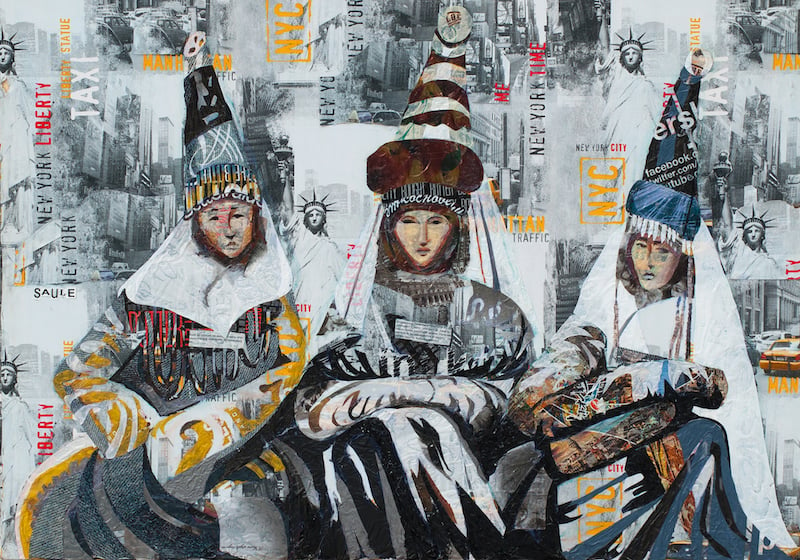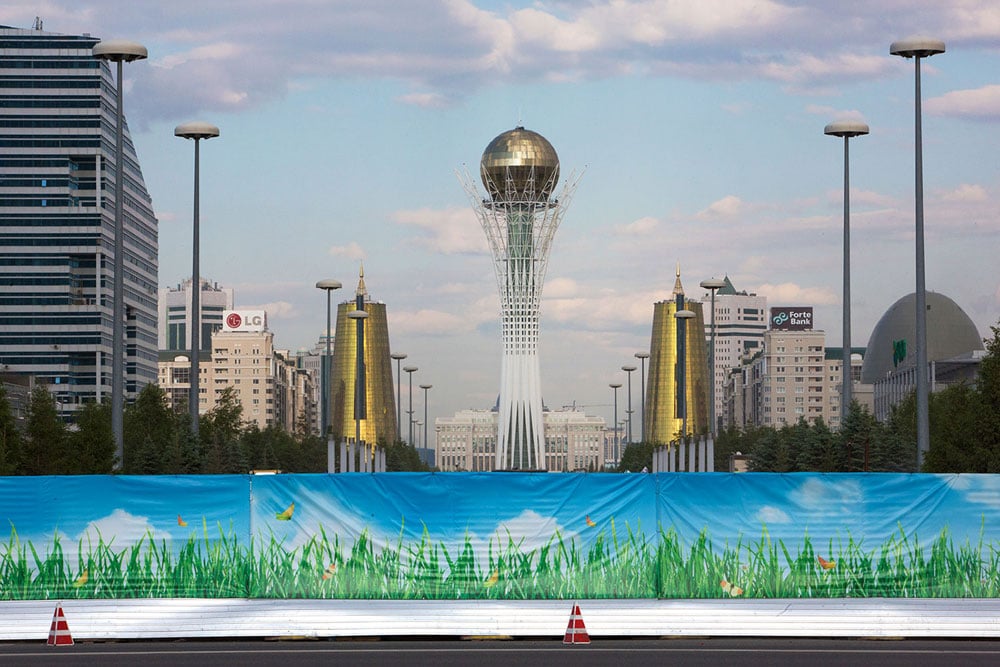One Kazakh artist is ripping up plastics — and the legacy of Soviet rule

Growing up in Almaty, Saule Suleimenova was influenced by her mother, who was an ethnomusicologist researching Kazakh music: a subject wildly considered “nonsense” by the Soviet academic circles at the time. She was advised to study Beethoven or Tchaikovsky instead. Instead, Suleimenova’s mother persisted, and devoted her life to proving that Kazakh music is no less complex, beautiful, or demanding than its European counterpart. It was only natural that when Suleimenova herself became an artist, she too would adopt decoloniality as a cornerstone of her art.
“The purpose of decolonial art is to reclaim your intrinsic value,” Suleimenova tells The Calvert Journal. For Kazakhstan, that means shaking free the legacy of Russian rule, which saw ethnic Kazakhs, their culture, and their language often supressed or viewed as second class. Portions of Kazakhstan were first annexed by the Russian Empire in 16th and 18th centuries, but perhaps the most devastating shift happened in the 1930s, when Soviet authorities began to force Kazakh nomads under their jurisdiction to settle into collective farms. The move not only triggered widespread famine, but swathes of Kazakh culture were lost.
A piece for Suleimenova’s series, Somewhere in The Great Steppe
Suleimenova uses plastic bags to explore that legacy. Reclaiming the material is a way of reclaiming the value to Kazakh culture. “Every human on the planet uses plastic, but very briefly. We deliver a product from a store in a plastic bag and immediately dispose of it,” the artist explains. “That dismissive attitude reminds me of how we treat our self-worth.” Suleimenova in turn redefines plastic as something beautiful and important. “I proclaim plastic to be a treasure,” she states firmly. The Kazakh motifs and images that she creates on these plastic canvases, once also discarded or throw-away, become treasures too.
Many of Suleimenova’s works are brightly-coloured, joyous, and even humorous. In Somewhere in The Great Steppe, which recalls Ed Ruscha’s slogan paintings, the artist portrays the boundless Kazakh steppe in every season, in locations that span the country. Others combine traditional Kazakh scenes with elements of modernity. One features the women in Kazakh national dress against a backdrop of the Statue of Liberty and Times Square in New York. The canvas is made from a New York souvenir oilcloth table cover from a local market. While often bought for a traditional Kazakh dastarkhan, or feast, many are emblazoned with these international motifs. For the artist, incorporating these elements of a creeping globalisation is, in its turn, a way of creating an image of a more authentic Kazakhstan.
“Kazakh women buy these kind of tablecloth for big feasts. People incorporate these [global] symbols into their life as something novel and cool,” she says. “To me, true ‘Kazakh-ness’, means authenticity, as opposed to the pre-set or polished images you might see on national TV.”
But Suleimenova’s use of plastic also signifies the dark role of colonialism in Kazakhstan’s past. Taking hundreds of years to decompose, a plastic bag does not cease to exist when you throw it away, she says. Memories have the similar quality: they linger in mind. Colonialism leaves marks on a country that reverberate through generations. In her exhibition Qaldyk Estelik (Residual Memory), Suleimenova addressed traumatic memories of Kazakhstan as a country, employing dark, subdued colours to depict national trauma.
Karlag concentration camp depicted in Suleimenova's Qaldyk Estelik (Residual Memory)
One artwork shows people toiling in the Karlag labour camp, where more than a million people were held between 1930 and 1959 as “enemies of people”. Another depicts families leaving their motherland during the famine of 1931-1933, after the Soviet government confiscated livestock to force Kazakhs to abandon their nomadic lifestyle. There is also a piece devoted to students killed at the Jeltoksan protests of 1986, which were brutally suppressed by Soviet law enforcement.
“These works honour the victims of the tragic events, many of whom were not even properly buried,” says Suleimenova. “This is my version of a Kazakh ritual when shelpek bread is cooked to feed the aruahs (ancestral spirits). For those paintings, I used food-related plastic, like grocery store bags and chocolate wrappers.”
Suleimenova is also aware of the environmental aspect of her work, although she never set out to make an eco-artistic statement. “At my first [cellophane] exhibition in 2017, I vehemently resisted when my art was classified by organisers as environmental activism,” she tells The Calvert Journal.
A piece from the series One Steppe Forward (2019)
Aside from its symbolic meanings, Suleimenova valued the plastic as adding authenticity to her work, even her picturesque renderings of natural landscapes. “If you travel through a Kazakh steppe, you will see tons of plastic littering the ground. Local shepherds leave a lot of trash in the grazing areas,” she explains. The artist is puzzled by idealised, garbage-free landscape paintings: “This is a lie. In reality, plastic has became an inseparable part of the steppe, with cellophane bags rolling there like tumbleweeds.”
Suleimenova has since become more accepting of the environmental messages many find in her work. In 2019, she taught a masterclass on cellophane painting for children at the Planet Art festival in Berlin. In 2020, she organised a project in the Kazakhstani capital, Nur-Sultan to attract attention to recycling, placing special eco-boxes where people could donate their used plastic bags. Some 4,000 bags were collected allowing Suleimenova to create the huge 5-meter installation The Sky Above Astana. In April 2021, she is doing a similar project in Dubai.
“I have no idea what kind of art I will create in the future,” she shared with The Calvert Journal. “But plastic bags as a material is still a barely touched avenue and there is a long way to go.”


